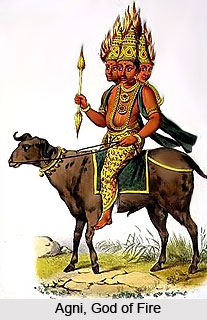 The Fire God in Agni Purana has also discussed human physiology in an elucidated manner. He has said that the organs are grouped under two sub-heads, as those of operation and intellection, and they number five in each of the groups. The five material elements are the objects of the five organs of sense-perception, which serve as five channels, through which the knowledge or information of the external world reaches the mind, the lord of them all. The soul is the supreme subjectivity which is imperceptible by the senses, and which lies amidst the twenty-four Tanmatras (fundamental material principles), as a fish floats in water, untouched by it.
The Fire God in Agni Purana has also discussed human physiology in an elucidated manner. He has said that the organs are grouped under two sub-heads, as those of operation and intellection, and they number five in each of the groups. The five material elements are the objects of the five organs of sense-perception, which serve as five channels, through which the knowledge or information of the external world reaches the mind, the lord of them all. The soul is the supreme subjectivity which is imperceptible by the senses, and which lies amidst the twenty-four Tanmatras (fundamental material principles), as a fish floats in water, untouched by it.
It has been mentioned in the Purana that the sensibilities of sound (hearing), touch, sight, taste, and smell, are the attributes of such sense organs, as the ears, the skin, the eyes, the tongue, and the nose; while the remaining principles of an animated human organism, are the intellect, and the sky.
The qualities of Sattva, Rajas, and Tamas, attach themselves to this invisible factor (Avyakta), while the inner thing is called the Purusha (the soul), which is a part of the eternal cause, the Para Brahman (the supreme soul). It has been said that he who knows this supreme Purusha, attains the highest position in eternal life.
Agni Purana says that the Jiva or the Soul, which is evolved out through a combined action of the blood and wind, is seated in the cavity of the heart, and consciousness, with its exponent of feelings and ideas are necessarily ensconced in that. The lungs (Kloma) on the other hand are situated on the right side of the heart. The veins and arteries give rise to the senses or Indriyas, which are the doors to our perception of the objective world. The bones form the foundation of a human organism.
This article is a stub. You can enrich by adding more information to it. Send your Write Up to content@indianetzone.com



















